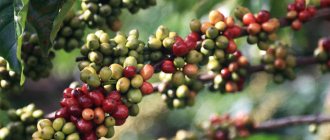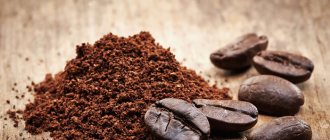When choosing coffee, consumers rarely focus on the place where the beans grow, but the taste and aroma properties of the drink, as well as its quality, depend on this indicator. Coffee raw materials are grown in 50 countries around the world, and about half are exported. Coffee producers do not always cultivate their beans, so the packaging also contains information about where they grow. Let's consider the rating of manufacturers of different types of drinks, both Russian and foreign.
World production volumes by region
The largest suppliers of coffee in the world are concentrated in South America - Brazil, Colombia, Peru, and Venezuela.
The total harvest volumes of these countries account for more than half of the world's harvest. According to the International Coffee Organization (ICO), 4,932,120 tons of coffee beans were harvested in South America last year.
Asia and Oceania is the second most important coffee region. Local leadership is firmly entrenched in Vietnam, followed by Indonesia. Over the past year, the harvest weight was 1,897,880 tons according to official statistics.
The turnover of Australia is taken into account separately - coffee is grown there primarily for its own market.
The climate suitable for growing coffee is tropical. Temperatures below +12C are critical for the harvest.
Mexico and Central America concentrate on growing primarily Arabica beans. The leaders among local coffee producers are Honduras (approximately 5% of global demand) and Mexico (3%). WITH
According to the ICO organization, turnover in this region over the past year amounted to 1,283,760 tons.
In most countries in central Africa, coffee cultivation is the main source of budget income. Work on plantations is the main source of employment for the local population.
According to the International Coffee Organization, over the past year, a crop weighing 1,119,900 tons was harvested in African countries.
Manufacturers of instant coffee
The most consumed coffee in our country is instant coffee, so it especially needs to be given attention. There is huge competition in this segment, so you can gain popularity only thanks to the quality of the product. It’s nice that two Russian companies are included in the ranking of the best.
Egoist coffee is distinguished by a high caffeine content, coffee-chocolate taste and bright aroma.
The leading positions were taken by:
- Egoiste is a German brand that produces Arabica-based freeze-dried coffee.
- Carte Noire is a brand owned by the American holding Mondelez. The line includes several types of freeze-dried drink made from Arabica blends. There is a slight bitterness and a balanced coffee taste.
- Bushido is a Swiss brand offering a wide range of coffee. The drink is created on the basis of Arabica beans from America, Indonesia and Africa. It is characterized by a bitter chocolate taste and a bright aroma of roasted beans.
- Moscow coffee shop on shares is a domestic manufacturer producing freeze-dried and powdered coffee. It has good taste with slight astringency, but no sourness.
- Jardin is a Russian brand that has established itself as a producer of high-quality medium-strength pure Arabica coffee. It has a light fruity sourness and a pleasant coffee and chocolate aroma.
There are plenty of coffee producing countries, as well as brands. It is difficult to make the right choice if there is no knowledge about the quality of raw materials imported from different parts of the world. Therefore, carefully read the presented rating to buy only the best.
6 Statistical Facts About World Coffee Production
- Every second coffee bean is grown in Brazil. Almost half of the world's turnover (3,775,500 tons) is cultivated in this country.
- More Arabica beans are grown than Robusta beans - 5,995,449 and 4,216,860 tons respectively.
- The countries of South America not only lead in coffee export volumes, but also increase their hegemony. Over the past year, the harvest of countries in this region increased by 13.9% (+ 603,000 tons).
- The countries of Central America and parts of North America have lost 1.5% of global turnover over the past year.
- Every year, coffee production in the world increases. Now the balance is +7.9% - 721,200 tons of growth per year.
- The Scandinavians are the world leaders in coffee consumption. Finland takes first place with an average of almost 12 kg of coffee per person per year. The second and third places are occupied by Norway and Iceland - 10 and 9 kg of coffee per person per year, respectively.
World import of coffee beans
EU imports are forecast to fall by 1.1 million bags to 48.0 million and account for more than 40 percent of global coffee bean imports. The largest suppliers are Brazil (29%), Vietnam (25%), Honduras (8%) and Colombia (6%). Ending inventories are expected to decrease by 400,000 bags to 14.0 million.
Table 3. World coffee imports
World coffee imports, according to USDA The
United States imports the second largest amount of coffee beans, and is projected to decline by 1.0 million bags to 26.2 million. The largest suppliers are Brazil (24%), Colombia (22%), Vietnam ( 15%) and Guatemala (6%). Ending stocks are forecast to fall by 500,000 bags to 6.9 million, but consumption is little changed after rising last year.
For nearly 70 years, the National Coffee Association of USA has conducted National Coffee Data Trends (NCDT), which tracks consumer behavior and perceptions that shape coffee trends in the United States. Introducing the infographic for the trend for 2021:
NCA infographic
Consumer representatives
All Japan Coffee Association (AJCA - All Japan Coffee Association),
Coffee Association of Canada (CAC- Coffee Association of Canada),
European Coffee Federation (ECF-European Coffee Federation),
Institute for Scientific Information on Coffee (ISIC- Institute for Scientific Information on Coffee),
National Coffee Association of the USA (NCA-National Coffee Association of USA),
Russian Association of Tea and Coffee Producers (Roschaykofe),
American Specialty Coffee Association (SCAA-Specialty Coffee Association of America),
European Specialty Coffee Association (SCAE - Specialty Coffee Association of Europe)
US Coffee Industry Key Indicators:
- The total economic impact of the coffee industry in the United States in 2015 was $225.2 billion.
- Coffee-related economic activity represents approximately 1.6% of the total U.S. gross domestic product. Consumers spent $74.2 billion on coffee in 2015
- The coffee industry accounts for 1,694,710 jobs in the US economy.
- The coffee industry generates nearly $28 billion in taxes (including ancillary products)
- In terms of household coffee consumption in this country, coffee ranks first in terms of consumption compared to other beverages with 43%.
Brand and brand of coffee
In English, the words “brand” and “brand” are synonyms. Often in modern Russian the terms are used as completely interchangeable. But there are still small differences between the concepts.
Until recently, “brand” meant a well-known trademark, while “brand” was a broader, general concept, a distinctive trademark. If we talk about today's situation and in the context of our topic, the phrase “coffee brand” implies all the company’s corporate symbols, what is associated with the company in the buyer’s mind. And “coffee brands” are the specific names of manufacturing companies or their products. That is, the brand already looks like a broader concept: a set of distinctive features of a coffee manufacturer, and not just one or two words.
However, few of us have analyzed this topic so deeply and not everyone means the same thing in terms. Therefore, we will use these words as equivalent.
Where do coffee trees grow?
There is a concept of the planet’s “coffee belt,” which covers regions within 10° north and south latitude on both sides of the equator. Within these boundaries there is never frost, there is enough warmth and moisture, and there is a small temperature range throughout the year. Although it is not only in this “belt” that coffee gardens bloom. Look at the map; the area of plantations is quite extensive. Over the centuries that man spent next to the Arabian coffee tree, he learned to cultivate it, protect it from diseases, fertilize the soil, and create favorable conditions for growth. Botanists and breeders are constantly working to improve the vitality and productivity of plants.
Planters who grow Arabica coffee trees face many problems. The plant is demanding of soil, amount of moisture, and air temperatures. But the quality of the grain and the taste of the drink made from it are excellent. The robusta variety is less demanding and more productive, which is why many countries successfully cultivate it. Moreover, this product is widely used for making instant coffee. Robusta has much more caffeine and bitterness, but the price is lower.
Large beans of the Liberica variety grown in Africa, although third in importance, do not even offer a hint of competition to the leading Arabica and Robusta beans. The quality of the fruits of the Liberian tree is lower, they contain little caffeine and are used mainly for making blends. Plus, Liberica is too dependent on weather conditions.
Another type of coffee grows in Africa with the romantic name Excelsa. She is capricious, wild and tall (grows up to 20 m). But it can resist parasites and harmful insects. For these qualities, breeders use it for grafting other species. Coffee lovers value rare coffee for the unique aroma that appears in the blend with the addition of Liberica.
Rating of producing countries
Most companies that offer coffee beans are roasters and packers. Manufacturers from those countries where the product is grown are especially valued.
Rating of coffee bean producing countries:
- Most coffee trees are grown in Brazil. Some consider its taste too simple, others love it for the presence of notes of cocoa, the absence of bitterness and impurities. Arabica and Robusta are grown in Brazil. Very often, when roasting, Brazilians add cinnamon or cloves. This is done in order to remove the specific smell (they have varieties grown on iodine soils) and deepen the taste.
- Guatemala specializes in the sale of green coffee, which is grown without the use of chemicals. The taste depends on the region where it is grown. Almost all coffee grown in this area has a subtle hint of smoke and characteristic hints of various spices. The most common Arabica variety is Typica.
- Ethiopia is the country where coffee first appeared. Mostly wild Arabica beans are harvested here. Approximately 40% of the harvest comes from man-made plantations. Coffee beans are cleaned using dry processing. The drink has a sour taste and a berry aftertaste. The best coffee beans are wet processed.
- Coffee production in Kenya is strictly controlled by the government. The most delicious drink is obtained from grains grown on the slopes of Meru and Kilimanjaro. It has a slight sour fruity taste.
- Colombian coffee varieties are highly valued throughout the world. Almost all plantations are located in high mountain areas, which has a beneficial effect on the quality of the product. For beans grown in the country, the name “Colombian coffee” is used; this trademark was registered in 2007. Thanks to the unique climate, special growing traditions, collection and processing of beans, the drink has an expressive aroma. In Colombia, only Arabica is grown.
Many well-known brands of bean coffee are grown in the Caribbean, in Yemen (the drink has fruity notes), in India (the taste of the coffee is mild but tart), in Cuba. Which one is better is difficult to answer, since connoisseurs choose according to personal taste preferences.











